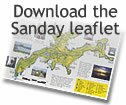Sanday Ranger
Roderick Thorne, Nearhouse, Sanday, Orkney, KW17 2BW - Tel
What's the Hogboon of Hellihow? When was Start Point Lighthouse first built? Where's the biggest sand-dune system in Orkney? Can you read a rune-stone? Come to Sanday and see if you can discover the answer to some of these questions.
 You'll also find out why so much of the island is prized by visiting naturalists, as well as by the folk who live there. The long, low rocky shoreline and endless sandy beaches are hugely attractive to wading birds and marine mammals. Purple sandpipers, Bar-tailed godwits, Dunlin and Sanderling are abundant through the winter; and in summer you're never far from the plaintive 'peep' of a Ringed plover. Inland, too, there's the constant backdrop of bird songs and calls. Lapwing and Skylark have all but disappeared in southern Britain; these, along with Oystercatchers, Redshank, Curlew, Arctic tern, gulls, sometimes even a Corncrake - all these are in full voice 59 degrees north. Both Grey and Harbour seals are easy to find, and look out for Otters, especially in those areas where freshwater lochs are close to the sea.
You'll also find out why so much of the island is prized by visiting naturalists, as well as by the folk who live there. The long, low rocky shoreline and endless sandy beaches are hugely attractive to wading birds and marine mammals. Purple sandpipers, Bar-tailed godwits, Dunlin and Sanderling are abundant through the winter; and in summer you're never far from the plaintive 'peep' of a Ringed plover. Inland, too, there's the constant backdrop of bird songs and calls. Lapwing and Skylark have all but disappeared in southern Britain; these, along with Oystercatchers, Redshank, Curlew, Arctic tern, gulls, sometimes even a Corncrake - all these are in full voice 59 degrees north. Both Grey and Harbour seals are easy to find, and look out for Otters, especially in those areas where freshwater lochs are close to the sea.
 The variety of colours of wildflowers on coastal paths and linksland is stunning - golden yellow of Marsh marigold, Buttercup, Bird's-foot trefoil and Tormentil; the pink and purple of Marsh orchids, Ragged robin, Hearts-ease, Spring squill, Campion; the white Grass of parnassus, Eyebright and Daisy.
The variety of colours of wildflowers on coastal paths and linksland is stunning - golden yellow of Marsh marigold, Buttercup, Bird's-foot trefoil and Tormentil; the pink and purple of Marsh orchids, Ragged robin, Hearts-ease, Spring squill, Campion; the white Grass of parnassus, Eyebright and Daisy.
Recently, a number of walks have been added to Orkney's 'core footpath network'. Backaskaill, Scar, Scuthvie, Tresness and Whitemill - every name of Viking origin - all are places on some of the eight different routes. All of these walks have been thoroughly well-planned; there are stiles to help you over the fences, and unobtrusive signs to reassure that you're still on the route. Walkers may collect a copy of the illustrated 'Walking Guide' to the island - a leaflet researched by the OIC's Access Officer and Sanday's Culture and Heritage Group - locally from Shops, Post Offices, Guest houses etc.
 Another recent innovation is the appointment, under the auspices of Sanday's Development Trust, of a Ranger for the island. During the period May to August inclusive, Roderick Thorne conducts a series of activities based on the island's heritage. These may include minibus excursions to explore the relics of World War 2; Viking and other archaeological sites; legends, folk-tales and place-names. Guided walks may include Tresness, Colliness and the Holms of Ire; and practical investigations involve lichens, rock-pools, sea-shells and Storm petrels. On Thursday evenings, every fortnight, he'll give an informal, illustrated 'Welcome to Sanday' talk in the Community School. While constructed with visitors in mind, these sessions are of course open to islanders - indeed they're encouraged to attend to correct his mistakes. Look out for notices locally, check our News and Events pages, or contact Rod at Nearhouse (Lady village), telephone . If you come to Sanday and you're interested in natural history, please leave a copy of your records with him.
Another recent innovation is the appointment, under the auspices of Sanday's Development Trust, of a Ranger for the island. During the period May to August inclusive, Roderick Thorne conducts a series of activities based on the island's heritage. These may include minibus excursions to explore the relics of World War 2; Viking and other archaeological sites; legends, folk-tales and place-names. Guided walks may include Tresness, Colliness and the Holms of Ire; and practical investigations involve lichens, rock-pools, sea-shells and Storm petrels. On Thursday evenings, every fortnight, he'll give an informal, illustrated 'Welcome to Sanday' talk in the Community School. While constructed with visitors in mind, these sessions are of course open to islanders - indeed they're encouraged to attend to correct his mistakes. Look out for notices locally, check our News and Events pages, or contact Rod at Nearhouse (Lady village), telephone . If you come to Sanday and you're interested in natural history, please leave a copy of your records with him.
 Do, please, remember that just about all of Sanday is farmed - and farmers are pretty busy much of the time, for example when they're 'at the silage'. Check the new Outdoor Access Code, especially if you're planning to bring a dog. Make sure your parked car isn't blocking access to a farm or field gate. For your own safety, avoid going into fields of cattle, particularly newly-calved cows. With these few caveats, you'll find that, within reason, you'll be welcome to walk wherever you like.
Do, please, remember that just about all of Sanday is farmed - and farmers are pretty busy much of the time, for example when they're 'at the silage'. Check the new Outdoor Access Code, especially if you're planning to bring a dog. Make sure your parked car isn't blocking access to a farm or field gate. For your own safety, avoid going into fields of cattle, particularly newly-calved cows. With these few caveats, you'll find that, within reason, you'll be welcome to walk wherever you like.
Roderick Thorne, Sanday Ranger
For more information about the Sanday Ranger, please click here.


